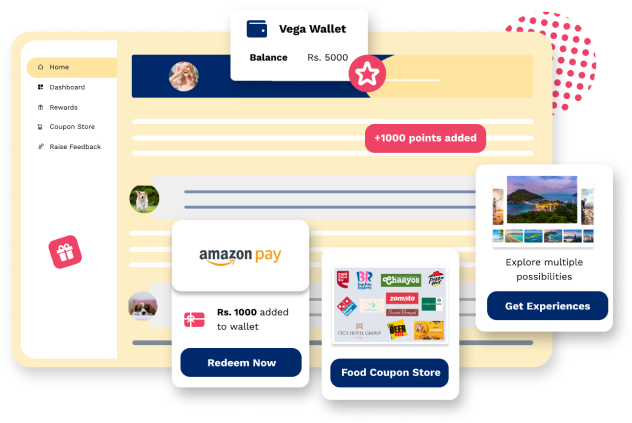Introduction
In today's fiercely competitive corporate world, the race to climb the ladder of success is on everyone's mind. Companies are continually looking for ways to accelerate employee productivity, engagement, motivation, and commitment to gain an edge in this competition. This is where employee reward segmentation comes into the picture, becoming an invaluable tool.
Reward segmentation empowers senior leaders and Human Resource professionals to explore innovative methods to achieve better results. Recognizing that each employee has unique requirements and preferences, some may prefer appreciation, while others value tangible rewards like trophies.
There may be more effective solutions than a one-size-fits-all approach to rewards for the entire workforce.

Source: Personaltoday
Consider this analogy: Just as your customers have diverse requirements for your products and services, you cater to their individual preferences to satisfy and engage them. The same process applies to your workforce.
Therefore, it makes perfect sense to customize your reward approach based on their specific needs to keep your employees content and motivated.
This blog will delve into reward segmentation, its significance, and how you can segment your workforce. Additionally, we will explore how to craft a tailor-made reward strategy that perfectly suits your unique team.
Get ready to elevate your employee reward program to the next level!
The Significance of Reward Segmentation
At its core, reward segmentation is about recognizing that employees are not a homogenous group; they are individuals with unique skills, motivations, and aspirations. Traditional rewards that apply to all employees indiscriminately need to acknowledge these differences, often resulting in disengagement and a lack of motivation. The Below image describes the drivers of employee engagement that segmentation can help with.
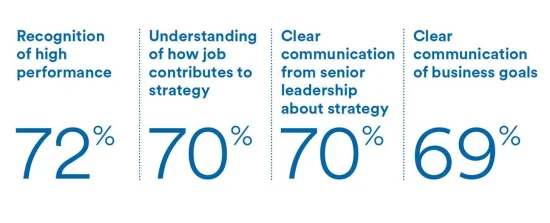
Source: Mercer
On the other hand, reward segmentation addresses these complexities by tailoring rewards to groups of employees based on factors like- longevity, performance, skills, preferences, and behaviors. By doing so, companies can curate a more personalized and meaningful approach to recognition, leading to employees who feel motivated, valued, and inspired to perform at their best.
Understanding the Various Ways to Segment Your Workforce
1. Age
A study by Mercer revealed that employees from different age groups place distinct significance on disparate aspects of the organization’s reward package. Older generations prioritize health benefits and retirement planning, while Millennials are more interested in career advancement opportunities such as - development, training, and mentoring.
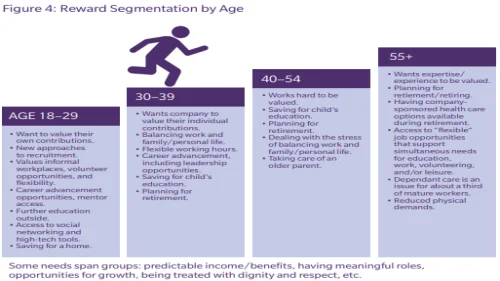
Source: Mercer
However, the study also uncovered areas of common interest among all generations. Factors such as a stable and predictable income, fulfilling job roles, and other shared desires underscore the importance of considering age when devising a reward segmentation plan. By acknowledging these age-based preferences, companies can effectively tailor their strategies to engage and motivate their diverse workforce.
2. Performance Improvement
Performance-based segmentation includes rewarding and recognizing employees based on team or individual performance. High-performing employees who continuously exceed expectations may receive stock options, special bonuses, or opportunities for career advancement. Moreover, employees who meet the requirements may receive standard bonuses, while those who are underperforming might get additional training or coaching to improve their skills.
3. Skill-Based
In skill-based segmentation, employees are rewarded based on their distinctive expertise and skills that are at par valuable to the organization. This can involve specialized training opportunities, certifications, or even the chance to lead projects in their area or domain of expertise.
4. Behaviour Based
Behavior-based segmentation focuses on rewarding positive values and behaviors that align with the organization’s culture. Recognizing employees for leadership, teamwork, or going above and beyond to assist colleagues fosters a supportive and collaborative work atmosphere.
5. Goal-Based
Aligning rewards with team and individual goals is an effective way to motivate employees. Employees can be rewarded with gift cards, bonuses, or additional time off when they achieve a particular target or contribute to crucial achievements.
6. Department/Division-Based
Different divisions or departments within an organization may have unique requirements and objectives. Companies can tailor incentives to encourage collaboration and foster healthy competition by segmenting rewards based on these areas.
7. Employee Preference-Based
Recognizing that employees have varied reward preferences, this approach boasts individuals to select their incentives. Some may prefer financial rewards, while others may value extra time off, flexible working hours, or opportunities for personal development.
Highlighting Some Core Benefits of Employee Reward Segmentation
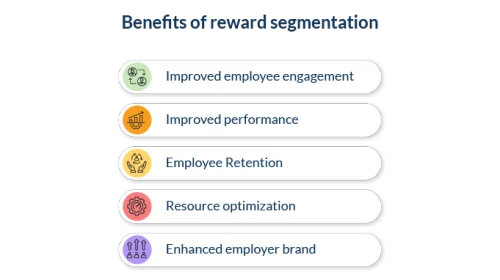
Improved Employee Engagement: By customizing rewards to align with individual goals and preferences, reward segmentation can increase employees' engagement and motivation. When employees feel appreciated and recognized for their efforts in a meaningful way, they are more likely to be invested in their work and committed to achieving the company's objectives.
Are You Ready to Supercharge Your Employee Engagement Initiatives?
Explore Vega HRs Comprehensive Suite of Employee Engagement Solutions Designed to Transform Your Workplace to Ensure Success.
Improved Performance: Segmenting rewards based on performance allows companies to reward and identify top performers more effectively. High-performing employees who receive incentives and recognition that match their contributions are encouraged to maintain their performance levels in a better way, leading to a more competitive and productive work atmosphere.
Employee Retention: Rewarding employees based on their specific requirements and aspirations fosters a sense of commitment and loyalty towards the company. When employees feel that their contributions are valued and their well-being is considered, they are more likely to stay with the company on a long-term basis, reducing costs and turnover rates.
Resource Optimization: Rewards segmentation allows enterprises to allocate their resources more efficiently. Instead of implementing a one-size-fits-all rewards system, organizations can focus their budget on incentivizing and recognizing the employees, making the most critical impact on the company’s success. This ensures that resources are utilized wisely and in a better and targeted manner.
Enhanced Employer Brand: A well-structured rewards segmentation strategy can contribute to an improved employer brand. When employees feel engaged, satisfied, and valued, they are more likely to share positive experiences about the organization as an employer. This can attract top talent and improve the company’s reputation in the cut-throat job market.
Overall, employee rewards segmentation recognizes the uniqueness of individual employees and acknowledges their different contributions to organizational success. It curates a more meaningful and personalized work experience, leading to a more productive and happier workforce. As a result, the company benefits from improved retention rates, increased performance, and a robust employer brand, ultimately adding to its long-term success.
Step-Wise Process of Rewards Segmentation
Rewards segmentation categorizes and tailor's employee R&R programs to meet disparate employee groups' specific preferences and requirements. This type of approach acknowledges that employees have different desires and motivations concerning rewards, and a one-size-fits-all approach may be more practical if required. Here's a step-wise process of the rewards segmentation:
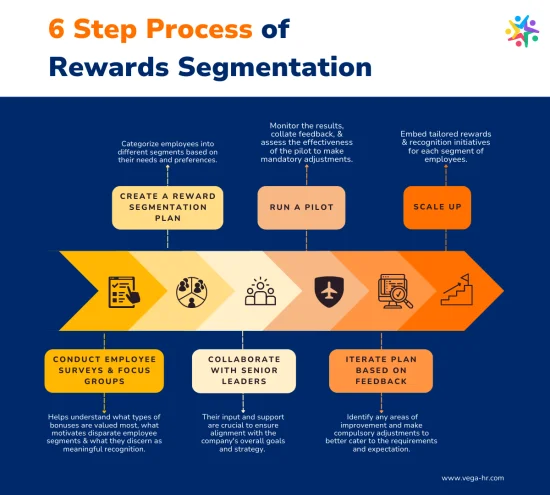
Step 1: Conduct Employee Surveys and Focus Groups: The primary step is to collate data and insights about your employees' priorities, motivations, and preferences related to rewards and recognition. Employee surveys and focus groups are apt methods to know what types of bonuses are valued most, what motivates disparate employee segments, and what they discern as meaningful recognition.
| Step 2: Create a Reward Segmentation Plan: Curating a reward segmentation plan based on the data collated in the prior step. This includes categorizing employees into different segments based on their needs and preferences. For instance, segments could be based on factors such as performance level, department, job role, years of service, or other relevant criteria that impact reward preferences.
|
Step 3: Collaborating with Senior Leaders: Involve key stakeholders and senior leaders in the process of reward segmentation. Their input and support are crucial to ensure alignment with the company's overall goals and strategy. Additionally, they can offer valuable insights and assist in addressing potential implementation complexities.
| Step 4: Run a Pilot: Before implementing the reward segmentation plan company-wide, run a pilot program. Choose a representative sample of workers from diverse segments and test the reward offerings tailored to their requirements. Monitor the results, collate feedback, and assess the effectiveness of the pilot to make mandatory adjustments.
|
Step 5: Refining the Plan Based on Feedback: Refine the reward segmentation plan based on the insights and feedback collected from the pilot program. Now, identify any areas of improvement and make compulsory adjustments to better cater to the requirements and expectations of each employee segment.
| Step 6: Scale Up: After fine-tuning the reward segmentation plan, scale up the program across the company. Embed tailored rewards and recognition initiatives for each segment of employees. Continually monitor the program's effectiveness and collect feedback to ensure ongoing improvements.
|
By following these steps, companies can curate a more impactful and personalized rewards and recognition strategy that engages and motivates employees in a more meaningful and targeted way. This, in turn, leads to increased productivity, job satisfaction, and employee retention.
Conclusion
Employee Reward segmentation is a robust tool that can unravel the strength of a motivated workforce. Companies can foster a culture of engagement, appreciation, and high performance by rewarding and recognizing employees in a targeted and personalized manner. Keep in mind, that reward segmentation is not about favoritism; it's about acknowledging the flawless contributions of each employee and creating an atmosphere where everyone feels motivated and valued to excel.
With the apt approach, reward segmentation can become a mainspring of an organization's success in retaining, attracting, and empowering top talent, eventually driving the organization forward in the current competitive business world.
Drop us a line at Vega HR today to learn more about our platform offerings.
About Vega HR
Vega-HR is a powerful tool in the talent war, offering employee rewards, recognition, and pulse recognition. With an engaging platform, it fosters a world-class work culture, providing P2P recognition, social feedback, on-spot recognition, and monetizable incentive solutions with 3000+ coupons in various categories.
Create a Culture People Want to Stick to
- Send rewards
- Give shoutouts
- Build a community
- Gift experiences
Get a demo
 Written by Ali Kidwai 24 August 2023 | 4 min read
Written by Ali Kidwai 24 August 2023 | 4 min read





